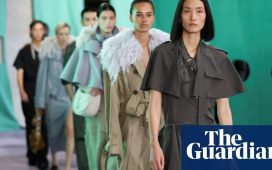Milan transforms once again into the
world’s fashion capital starting Tuesday, with Spring-Summer 2025 women’s
shows rolling out amid a global slowdown in luxury apparel — and without
longtime local icon Giorgio Armani.
A challenging environment for fashion won’t stop the shows, however, which
run through Sunday and kick off with Fendi.
The best in women’s fashion benefits this year from the addition of one
more day, the better to squeeze in 57 live catwalk shows attended by buyers,
reporters and other industry professionals.
Highlights of the week include Italy’s best-known luxury fashion labels,
from Prada and Gucci to Bottega Veneta, Versace and Dolce & Gabbana.
But Fashion Week stalwart Giorgio Armani will not be showing his namesake
line, having chosen New York for his women’s collection on October 17, timed
to coincide with the inauguration of a new building on Madison Avenue.
His mid-level Emporio Armani line, however, will get two shows in Milan,
followed by a party Thursday in the futuristic theatre located at his fashion
headquarters.
Moncler has also shunned Milan this season, opting for Shanghai for its
show on October 19, with MSGM, Blumarine and Tom Ford also absent from the
calendar.
Less rosy
In presenting Milan Fashion Week’s lineup to the press, the general
director of Agenzia ICE, a division of Italy’s Trade Agency that promotes
Italian companies abroad, highlighted the industry’s 108 billion euros ($120
billion) in turnover and exports of 81.6 billion euros.
In Italy, “the fashion system is the one that contributes more than others
to consolidating the image of our country’s excellence abroad,” he said.
A crucial sector that represents five percent of Italy’s gross domestic
product (GDP), the health of Italy’s fashion industry is currently less rosy
than the coming glamorous catwalk shows would suggest.
So far this year, turnover is down 6.1 percent, according to figures from
the National Chamber for Italian Fashion, with the trend expected to continue
in the second half of the year.
Forecasts suggest the industry’s revenue this year will end up down 3.5
percent from 2023 levels, with recent results from top luxury groups
confirming the findings, which are in sharp contrast to years of double-digit
growth.
French luxury conglomerate LVMH, which owns the Italian brands Fendi and
Loro Piana, saw its 2024 first-half revenue slip one percent to 41.7 billion
euros ($46.4 billion).
Rival Kering — owner of Gucci and Bottega Veneta — saw an 11 percent drop
in revenue to nine billion euros, with net profit falling by half.
Kering warned that operating earnings in the second half of the year would
be down by about a third.
The difficult economic headwinds, fuelled by weakness in the key market of
China along with inflation and weak consumer confidence, have pushed fashion
houses to restructure, reorganise their teams or diversify.
Milan Fashion Week is not only a crucial marketing and sales event for the
industry, but it plays a major economic role for the industrial city itself.
A study carried out by Milan chapter of business association Confcommercio
found the city stands to reap 396 million euros from this month’s shows and
the upcoming February fashion week — calculated in hotel nights, restaurant
reservations and other activity.
Around 245,000 people, of which 56 percent are Italians, flood the city
during the two weeks of Milan fashion, spending on average 1,638 euros per
person per edition.(AFP)













